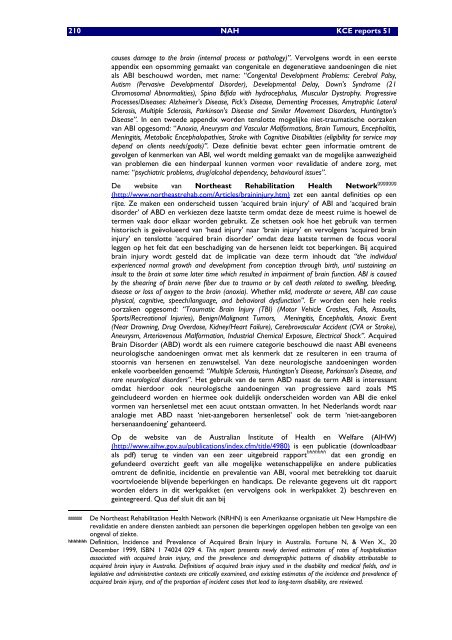Chronische zorgbehoeften bij personen met een NAH - KCE
Chronische zorgbehoeften bij personen met een NAH - KCE
Chronische zorgbehoeften bij personen met een NAH - KCE
Create successful ePaper yourself
Turn your PDF publications into a flip-book with our unique Google optimized e-Paper software.
210 <strong>NAH</strong> <strong>KCE</strong> reports 51<br />
causes damage to the brain (internal process or pathology)”. Vervolgens wordt in <strong>een</strong> eerste<br />
appendix <strong>een</strong> opsomming gemaakt van congenitale en degeneratieve aandoeningen die niet<br />
als ABI beschouwd worden, <strong>met</strong> name: “Congenital Development Problems: Cerebral Palsy,<br />
Autism (Pervasive Developmental Disorder), Developmental Delay, Down's Syndrome (21<br />
Chromosomal Abnormalities), Spina Bifida with hydrocephalus, Muscular Dystrophy. Progressive<br />
Processes/Diseases: Alzheimer's Disease, Pick's Disease, Dementing Processes, Amytrophic Lateral<br />
Sclerosis, Multiple Sclerosis, Parkinson's Disease and Similar Movement Disorders, Huntington's<br />
Disease”. In <strong>een</strong> tweede appendix worden tenslotte mogelijke niet-traumatische oorzaken<br />
van ABI opgesomd: “Anoxia, Aneurysm and Vascular Malformations, Brain Tumours, Encephalitis,<br />
Meningitis, Metabolic Encephalopathies, Stroke with Cognitive Disabilities (eligibility for service may<br />
depend on clients needs/goals)”. Deze definitie bevat echter g<strong>een</strong> informatie omtrent de<br />
gevolgen of kenmerken van ABI, wel wordt melding gemaakt van de mogelijke aanwezigheid<br />
van problemen die <strong>een</strong> hinderpaal kunnen vormen voor revalidatie of andere zorg, <strong>met</strong><br />
name: “psychiatric problems, drug/alcohol dependency, behavioural issues”.<br />
De website van Northeast Rehabilitation Health Network ggggggg<br />
(http://www.northeastrehab.com/Articles/braininjury.htm) zet <strong>een</strong> aantal definities op <strong>een</strong><br />
rijte. Ze maken <strong>een</strong> onderscheid tussen ‘acquired brain injury’ of ABI and ‘acquired brain<br />
disorder’ of ABD en verkiezen deze laatste term omdat deze de meest ruime is hoewel de<br />
termen vaak door elkaar worden gebruikt. Ze schetsen ook hoe het gebruik van termen<br />
historisch is geëvolueerd van ‘head injury’ naar ‘brain injury’ en vervolgens ‘acquired brain<br />
injury’ en tenslotte ‘acquired brain disorder’ omdat deze laatste termen de focus vooral<br />
leggen op het feit dat <strong>een</strong> beschadiging van de hersenen leidt tot beperkingen. Bij acquired<br />
brain injury wordt gesteld dat de implicatie van deze term inhoudt dat “the individual<br />
experienced normal growth and development from conception through birth, until sustaining an<br />
insult to the brain at some later time which resulted in impairment of brain function. ABI is caused<br />
by the shearing of brain nerve fiber due to trauma or by cell death related to swelling, bleeding,<br />
disease or loss of oxygen to the brain (anoxia). Whether mild, moderate or severe, ABI can cause<br />
physical, cognitive, speech/language, and behavioral dysfunction”. Er worden <strong>een</strong> hele reeks<br />
oorzaken opgesomd: “Traumatic Brain Injury (TBI) (Motor Vehicle Crashes, Falls, Assaults,<br />
Sports/Recreational Injuries), Benign/Malignant Tumors, Meningitis, Encephalitis, Anoxic Event<br />
(Near Drowning, Drug Overdose, Kidney/Heart Failure), Cerebrovascular Accident (CVA or Stroke),<br />
Aneurysm, Arteriovenous Malformation, Industrial Chemical Exposure, Electrical Shock”. Acquired<br />
Brain Disorder (ABD) wordt als <strong>een</strong> ruimere categorie beschouwd die naast ABI even<strong>een</strong>s<br />
neurologische aandoeningen omvat <strong>met</strong> als kenmerk dat ze resulteren in <strong>een</strong> trauma of<br />
stoornis van hersenen en zenuwstelsel. Van deze neurologische aandoeningen worden<br />
enkele voorbeelden genoemd: “Multiple Sclerosis, Huntington's Disease, Parkinson's Disease, and<br />
rare neurological disorders”. Het gebruik van de term ABD naast de term ABI is interessant<br />
omdat hierdoor ook neurologische aandoeningen van progressieve aard zoals MS<br />
geincludeerd worden en hiermee ook duidelijk onderscheiden worden van ABI die enkel<br />
vormen van hersenletsel <strong>met</strong> <strong>een</strong> acuut ontstaan omvatten. In het Nederlands wordt naar<br />
analogie <strong>met</strong> ABD naast ‘niet-aangeboren hersenletsel’ ook de term ‘niet-aangeboren<br />
hersenaandoening’ gehanteerd.<br />
Op de website van de Australian Institute of Health en Welfare (AIHW)<br />
(http://www.aihw.gov.au/publications/index.cfm/title/4980) is <strong>een</strong> publicatie (downloadbaar<br />
als pdf) terug te vinden van <strong>een</strong> zeer uitgebreid rapport hhhhhhh dat <strong>een</strong> grondig en<br />
gefundeerd overzicht geeft van alle mogelijke wetenschappelijke en andere publicaties<br />
omtrent de definitie, incidentie en prevalentie van ABI, vooral <strong>met</strong> betrekking tot daaruit<br />
voortvloeiende blijvende beperkingen en handicaps. De relevante gegevens uit dit rapport<br />
worden elders in dit werkpakket (en vervolgens ook in werkpakket 2) beschreven en<br />
geintegreerd. Qua def sluit dit aan <strong>bij</strong><br />
ggggggg De Northeast Rehabilitation Health Network (NRHN) is <strong>een</strong> Amerikaanse organisatie uit New Hampshire die<br />
revalidatie en andere diensten aanbiedt aan <strong>personen</strong> die beperkingen opgelopen hebben ten gevolge van <strong>een</strong><br />
ongeval of ziekte.<br />
hhhhhhh Definition, Incidence and Prevalence of Acquired Brain Injury in Australia. Fortune N, & Wen X., 20<br />
December 1999, ISBN 1 74024 029 4. This report presents newly derived estimates of rates of hospitalisation<br />
associated with acquired brain injury, and the prevalence and demographic patterns of disability attributable to<br />
acquired brain injury in Australia. Definitions of acquired brain injury used in the disability and medical fields, and in<br />
legislative and administrative contexts are critically examined, and existing estimates of the incidence and prevalence of<br />
acquired brain injury, and of the proportion of incident cases that lead to long-term disability, are reviewed.

















